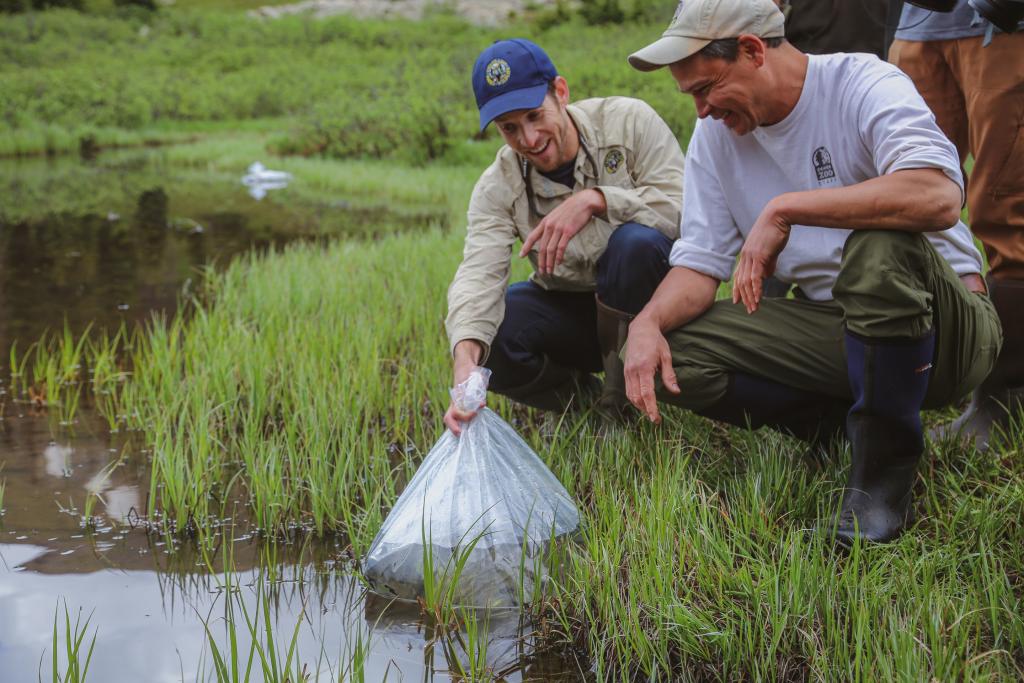Denver Zoo, CPW release endangered boreal toad tadpoles into wild

 John Livingston
John LivingstonSouthwest Region Public Information Officer
970-759-9590 / [email protected]
@CPW_SW
 Jake Kubié
Jake KubiéDirector of Communications
Denver Zoo
720-337-1644 / [email protected]

MEDIA B-ROLL AND PHOTOS: Boreal Toad Tadpole Release on June 28
“This was the result of a tremendous amount of hard work and planning by our partners at Colorado Parks and Wildlife, and members of our animal care and field conservation teams,” said Erica Elvove, Senior Vice President for Conservation Engagement and Impact at Denver Zoo. “Boreal toads face an extremely uncertain future in Colorado and have a good chance of going extinct without human intervention. We’re committed to continuing this effort with CPW for many years to come, and doing our part to make sure the species remains part of Colorado’s ecosystem for future generations.”
Once common in montane habitats between 7,000-12,000 feet in the Southern Rocky Mountains, the boreal toad has experienced dramatic population declines over the past two decades. The decline appears to be related to habitat loss and primarily infection by the chytrid fungus, which can infect the majority of the world’s 7,000 amphibian species, and is linked to major population declines and extinctions globally. Officials estimate there may be as few as 800 wild adult toads left in Colorado.
“It was a very special day to join our partners from Denver Zoo to release boreal toad tadpoles that the Zoo produced at their facility,” said Daniel Cammack, Southwest Region Native Aquatic Species Biologist with CPW. “We’ve been stocking tadpoles at this site for about five years now, and we have high hopes that the tadpoles we introduced will contribute to a self-sustaining breeding population. It’s a pretty big win for boreal toad conservation.”
Denver Zoo has been conserving endangered and critically endangered amphibian species for more than 15 years. In 2018, the Zoo became the first zoo in the Northern Hemisphere to successfully breed critically endangered Lake Titicaca frogs, and has since provided more than 250 healthy frogs to zoos and aquariums in the U.S. and Europe. In 2019, the Zoo used a hormone treatment to breed and produce more than 600 boreal toads, which were released in a remote area in southwestern Utah. And in 2021, the Zoo successfully bred critically endangered Panamanian golden frogs as part of the Association of Zoos and Aquarium’s Species Survival Plan.
CPW has devoted significant resources in the past 20 years toward researching the cause of boreal toad declines in the state and exploring ways to recover the species. Specifically, CPW researchers focus on developing methodologies for reintroducing toads in historically occupied habitats, detecting chytrid fungus in the wild, marking and identifying individual toads and improving breeding success at the Native Aquatic Species Restoration Facility, which plays a critical role in the state’s efforts to restore populations of boreal toads.
"The boreal toad is a really unique amphibian," Cammack said. "We are up at 11,500 feet at timberline practically, and they are gutting out these big winters covered by snow. They are an integral part of the landscape and were ubiquitous once in Colorado in this habitat. With chytrid fungus now being the primary cause of decline, we don’t have that many populations of boreal toad remaining. For us to get something else going is really important."
Officials from the Zoo and CPW estimate that it will take many years to bring the species back to a level where it is secure in the Southern Rocky Mountains, and expect the collaboration to be a multi-year program. Additionally, as part of the wild release program, the Zoo launched a community science project where volunteers monitor the species’ high-country habitat to help officials understand the health of current wild populations and determine suitable locations for future reintroduction of toads bred at the Zoo. For more information, visit DenverZoo.org/Boreal-Toad-Conservation-Team.
ABOUT DENVER ZOO
Home to almost 3,000 animals representing more than 450 species, Denver Zoo is a non-profit 501©(3) organization, and the city’s oldest and most passionate advocate for the natural world. The Zoo is among the most visited cultural destination in Colorado, serving almost 2 million people per year, and accredited by the Association of Zoos and Aquariums (AZA), which assures the highest standards of animal care. With the mission inspiring communities to save wildlife for future generations, Denver Zoo dedicates almost $2 million annually to Zoo-led programs aimed at protecting animals within their natural habitats around the world. For more information, visit DenverZoo.org.
LEFT: A boreal toad estimated to be a 4-year-old is pictured in the wetlands where boreal toad tadpoles were recently stocked by the Denver Zoo and CPW. John Livingston/CPW
RIGHT: A 1-year-old boreal toad tadpole is pictured in the wetlands where boreal toad tadpoles were recently stocked by the Denver Zoo and CPW. John Livingston/CPW


Colorado Parks and Wildlife (CPW) is an enterprise agency, relying primarily on license sales, state parks fees and registration fees to support its operations, including: 43 state parks and more than 350 wildlife areas covering approximately 900,000 acres, management of fishing and hunting, wildlife watching, camping, motorized and non-motorized trails, boating and outdoor education. CPW's work contributes approximately $6 billion in total economic impact annually throughout Colorado.
DISCLAIMER: The Colorado Parks and Wildlife (CPW) website maintains press releases containing historical information that may no longer be accurate. Press releases are dated, which should be noted to determine whether the information provided is current. Please review our current regulations and brochures for up-to-date information.